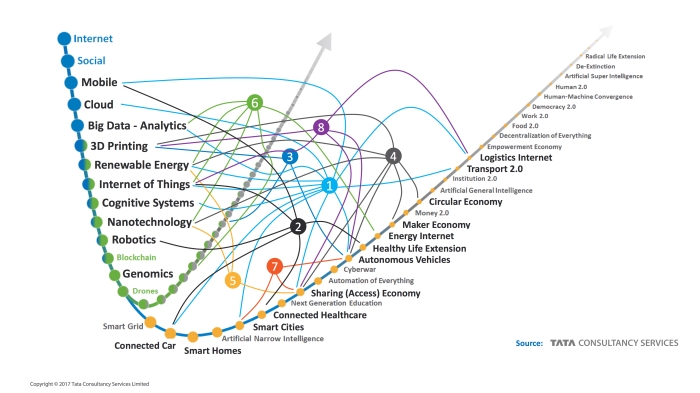I participated in a radio show yesterday brought to you by Coffee Break with Game Changers. The show was hosted by Bonnie D. Graham and is now available on-demand here. When asked about a leadership trait required to effectively navigate our exponential future, I echoed something I have positioned many times via this Blog: Connecting Dots. The speed dimension that has accelerated our pace will put those dots in constant motion – so it’s a continuous state of connecting that makes this more challenging than our forward looking efforts of the past. The foundation for this argument was positioned in my post describing how Disruptive Power Lies at the Intersections. This visual from that post leverages my anchor visual on our emerging future.
Overwhelming at first, but when you follow each thread, you get a cleaner visual that views each dot as an innovation component that combines with others to create value. This dynamic alone creates the challenge of pace, as many of these building blocks are maturing and enabling creative minds to deliver combinatorial impact. Let’s follow one thread:

Science and technology innovation components combine with emerging future scenarios to enable our emerging autonomous vehicle scenario. The autonomous vehicle itself becomes an innovation component that spawns new future scenarios like Transport 2.0, the Logistics Internet, and the automation of everything.
When we add the societal dimension to this, we add complexity to our connecting dots efforts. In a post on Technology, Social Change, and Future Scenarios I added the societal dimension to the emerging futures visual and described a dot connecting example. In the example below, several of the social changes are linked with one specific future scenario – showing the interplay between the curves at the societal dimension. This Citi Report describes the continued lowering of fertility rates and the implications of an aging population. One of those implications is the fall of the working age population (ages 15 – 64). So, three of the social changes are linked (fertility rates, aging population, and fall of working age population). At the same time, the future scenario labeled automation of everything (advanced robotics, automation of knowledge work. etc.) is driving a growing concern over social changes related to technological unemployment. In a future thinking context, connecting these dots can drive two very different perspectives. The first view is the one that gets all the attention; the anticipated level of automation will drive significant technological unemployment. The Citi report provides some very sobering numbers by country and even city. But a very different view has the automation scenario solving the issues associated with a decline in working age population. Said another way, is the automation scenario moving towards solving an emerging social issue – or creating a new one?

Using this visual as a framework, we’ve connected these dots:

As discussed on the show yesterday, the role of Futurist is back in vogue – and every organization needs to focus here. Connecting dots with a strong dose of creativity, innovative, systems and design thinking will be high on the list of traits that the Futurist in you will have to embrace.

[…] Fonte: Frank Diana […]
LikeLike
[…] seu artigo de 13/07/16, ele […]
LikeLike
[…] das sociedades e futuro dos negócios, a resposta é a habilidade para conectar os pontos. No seu artigo de 13/07/16, ele […]
LikeLike
[…] recent blog from Frank Diana highlights very well the powerful impact of connecting the dots or combinatorial thinking and […]
LikeLike
[…] tecnológicos que se configuram como as smart cities, industria 4.0, economia maker entre outras (case Frank Diana […]
LikeLike
[…] tecnológicos que se configuram como as smart cities, industria 4.0, economia maker, etc. (case Frank Diana […]
LikeLike
[…] of brain science as an example of that virtuous cycle at work. As a result, our ability to Connect Dots in meaningful ways is critical to navigating this complex and uncertain world, where the […]
LikeLike
[…] tecnológicos que se configuram como as smart cities, industria 4.0, economia maker, etc. (case Frank Diana […]
LikeLike
[…] of populists that indicate a serious discontent among millions of American voters. He talks about Connecting these Dots in ways that allow us to deal with these cracks before they accumulate to a level where a great […]
LikeLike
[…] if we didn’t have enough Dots to Connect, this pandemic has introduced more uncertainty and complexity. As I have in every virus-related […]
LikeLike
[…] Each domain requires our attention, for it is the collective that determines our future and the Connections that show us the path. Books like this help us understand these domains, while illuminating the […]
LikeLike
[…] of voters. The current situation in Ukraine is yet another canary. These canaries force us to Connect Dots in ways that allow us to deal with these cracks before they accumulate to a level where a […]
LikeLike